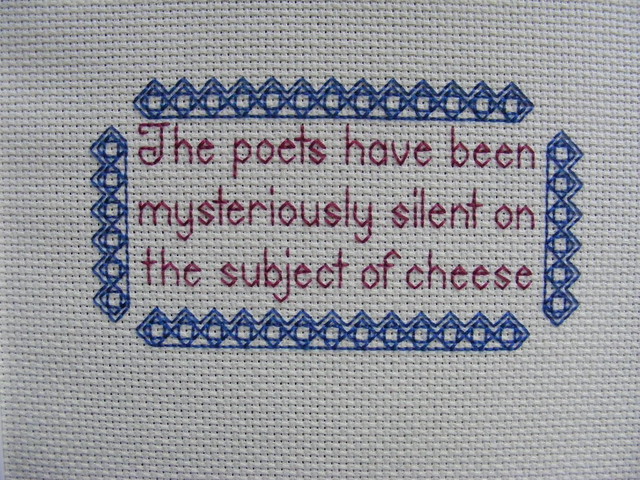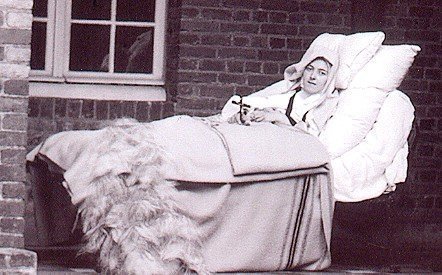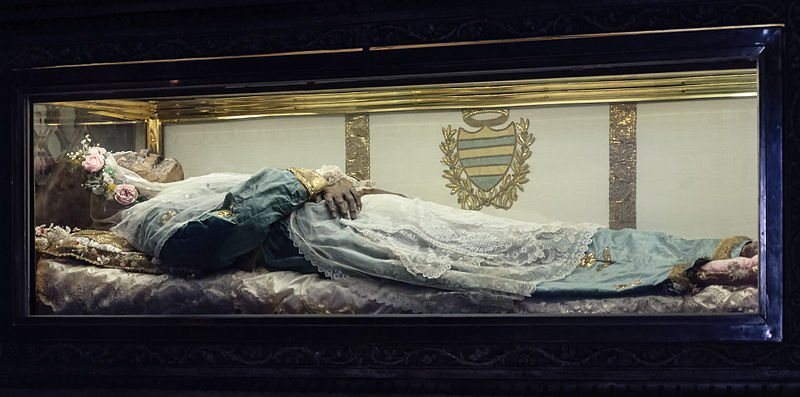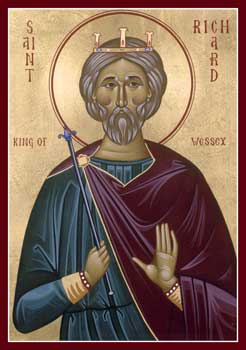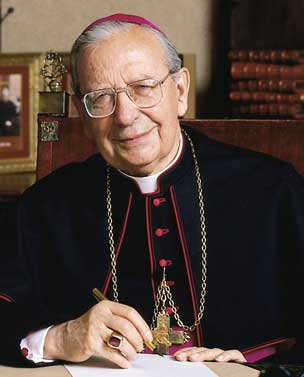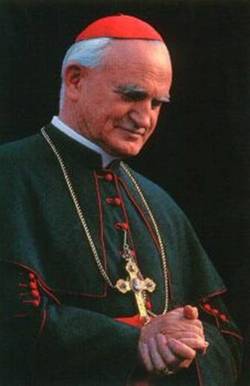Today, as you know, is the feast of St Agnes, virgin and martyr, often associated with sheep since her name, Agnes is close to the word “agnus”, the Latin for lamb; in fact her name is derived from the Greek “hagia” “pure or holy”, from which we also get Saint. The connection has led to her virtues, virginity and death being compared with those virtues of innocence and purity symbolised by the lamb; and of course we cannot forget the connection with the Lamb of God in whose passion she participated through her martyrdom.
Agnes, like St Lucy, was young, and she is also associated with littleness – childlikeness. It is believed that she was young when martyred, perhaps as young as twelve, and so we see in her that spiritual childhood Jesus often spoke about, but married with courage and determination to remain faithful to Christ. She has been venerated as a patron of young people, particularly invoked to help the young live chaste lives. Well, in an age when the young are being ensnared into promiscuity, Agnes is a worthy intercessor. Young people struggle with their sexuality – their hormones are all over the place, so chastity can be difficult. Unfortunately there are many distractions and temptations which assail them and many of our young fall.
A friend of mine was telling me about the sex classes his seven year old nephew is attending in school in England – already the child knows all about sex and how babies are made. Soon enough he will be putting condoms on bananas and taught to chant the liberal secular mantras associated with the sexual revolution. It is no wonder children begin to experiment and end up in trouble. The number of young people suffering from STDs and STIs is increasing fast and at this stage, listening to some doctors and sexual health workers, it is expected that many teenagers will have some disease or infection – it is almost a norm. Of course, contrary to what we are being told, and despite the wide availability of contraception, teenage pregnancies are on the increase and so many young girls resort to the abortion clinics. One would almost think there was a conspiracy of promiscuity in order to keep these clinics in business.
Organisations like
Pure In Heart are doing the best they can to help young people resist the temptations and to live fulfilled, chaste lives. They are worth checking out and promoting. Very much in the spirit of St Agnes, the members of
Pure In Heart teach about true love, chaste love, seeing sexuality in the context, not only of purity of heart and life, but also in the context of commitment and life-long love – in marriage. And far from being prudes, as some would paint them, members of the organisation are some of the happiest, joyful and serene teenagers you’ll meet.
As I’m on the subject of a virgin martyr, I would like to draw your attention to another Saint who is not as well known as Agnes – St Vibiana. First of all
here is an interesting article on her. She is virgin martyrs whose body has been enshrined for last 120 years in the Cathedral in Los Angeles. Originally in a glass casket above the altar in the old Cathedral which was dedicated to her, she now lies in a marble tomb in an alcove in the crypt of the new Cathedral.
Little is known of St Vibiana, and she is sometimes confused with St Bibiana. A martyr of the 3rd century, her remains were discovered in the catacombs on the Via Appia in 1853, together with an inscription which announced “To the soul of the innocent and pure Vibiana”. As happened in the 19th century, her relics were entrusted to the bishop of Los Angeles as a gift from the Holy See to the people of the diocese, and so, like many Italians, she took the boat to America and is now a “native” of the Archdiocese. I believe she is the patron saint of the diocese.
The article reflects on the fact she is, for the most part, unknown, in a city where fame, and the desire to be famous, rules. Los Angeles is the “spiritual home” of celebrity – Hollywood is there, and so are thousands of men and women eking out a living in the hope of one day “making it big” – few do. St Vibiana offers us another value, a Christian virtue – hiddenness. St Paul speaks of this in his Letter to the Colossians, of being “hidden with Christ in God”, and it is very much part of the virtue of humility. Unknown on earth, Vibiana, like many others, is famous in heaven – known to God, and in comparison with Warhol’s fifteen minutes of fame, it is a far better way of life.
In a way this hiddenness allows us to be ourselves and to grow in holiness. Those who seek fame realise that they need to offer the world an image, something that stands out from the ordinary, and so they may have to assume a mask, another personality, indeed at times another life, in order to catch the camera’s attention. If fame is achieved they well have to live this new persona for life and while it may seem exciting at the start, soon it is a burden and eventually the person may not know who they are at all. The greatest actors are those who are themselves in their ordinary lives – they do not seek fame, they just enjoy their work and go home to their families to live as normal a life as they can. It is no coincidence that Vibiana is in the city of the stars.
The best fame is, of course, holiness – to be known for a saintly life and even a heroic death. That fame tends to emerge from hiddenness, as St Paul explains in the Letter to the Colossians – those who are hidden with Christ in God are revealed when Christ is revealed. Yesterday I found out that one of the members of the White Rose resistance movement in Munich had been canonised by the Orthodox Church. Alexander Schmorrell, one of the leaders of the group and a member of the Orthodox Church, was recognised as a New Martyr last year. Those young people certainly displayed great courage in their resistance to the Nazis, and that resistance had its source in the Christian faith.
The two more famous members of the group, Sophie Scholl and her brother, Hans, were fans of Blessed John Henry Newman and other Catholic writers, though they were Lutheran. In fact evidence has emerged that they were intending to convert to Catholicism. Indeed when they were in prison, they were making moves to be received into the Church, but a Lutheran minister persuaded them not to for their mother’s sake: as devout Lutheran it was bad enough for her to see her children executed, but to hear that they had become Catholics and left the Lutheran community would have destroyed her. In charity they decided not to. However I believe they died Catholics, and while they were already baptised in the Lutheran church, taking the theological cue from the concept of “baptism by desire”, I think they were Catholics already through desire.
That now raises an interesting question – could Sophie and Hans be considered for canonisation? I have little doubt that certainly Sophie would have been put forward if she had formally been received: her life and courage is like that of many of our World War II martyrs. She was a young woman of profound faith, innocence, goodness and joy: all marks of her holiness. Now the Church has no authority to declare non-Catholics saints, but if the Church could prove martyrdom in their case, would it be possible to examine the evidence and see if Sophie and Hans were in communion with the Church by desire? That’s an interesting one for the canon lawyers.
There is another member, however, who offers us an easier task – their companion in death, Christoph Probst. Christoph was a member of the movement, but at a remove since he was a married man with children and he had to provide for his family and be prudent so as not to expose them to any danger. Born in 1919, Christoph grew up in an artistic and academic family. His father was married twice, his second wife being Jewish, and so Christoph was very much opposed to the Nazis anti-semitic agenda. After compulsory military service, he began to study medicine in order to be of service to the sick. When he was 21 he married Herta Dohrn, a young Catholic woman, and it was through her that he came to learn about Christianity in general and Catholicism in particular. She was a devout young woman, and soon he was being led to faith. They had three children, the last being born just before his arrest.
As a member of the White Rose, Christoph did not write any of the letters but designed the format for the seventh, and when he was arrested he was found with a draft of this letter on him. In his trial he pleaded for clemency for the sake of his family, but the judge sentenced him to death. When in prison, Christoph asked to be baptised into the Catholic Church, and he was received the day before his execution. He died, by guillotine, with Sophie and Hans on the 22nd February 1942. His remains are buried beside theirs in Munich, outside the prison where they died.
Given that he was a Catholic when he died, and already on the way to conversion in the months leading up to his arrest, Christoph poses no problems canonically. If martyrdom could be proved in his case, then glorification would offer the Church a wonderful example of courage and prudence: Christoph was doing the right thing, resisting an evil regime, yet also conscious of his duties to his family, and so sought a virtuous balance between the two. Too often martyrdom can be seen a foolhardy thing, where the martyr has, in a sense, to deny family in order to offer his or her life for Christ, as with St Thomas More, and that is the case. Christoph offers us another example: he embraced his death but also sought to do what he could to provide for his family – his plea for clemency was not a cowardly act.
I think we should look at Christoph’s life and see if something can be done. And if nothing comes of it, well what harm: he still remains one of the great heroes of the Church and one of Germany’s finest sons.









